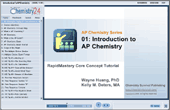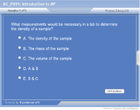Introduction to Advanced Placement Chemistry
| Topic Review on "Title": |
AP Chemistry is a college general chemistry course taught in the high schools. In May, and exam is given that students can take. Their score (1-5) and the college they attend will determine if and how much college credit they earn for taking the course. The test is written to cover every topic…they do not expect any one student to know everything on the exam. You can get the best score (5) without knowing every topic!
The exam has 2 sections—90 minutes Multiple Choice and 90 minutes Free Response
Multiple Choice section:
- 90 minutes
- No calculators—only a periodic table
- 75 questions
- Tips:
- Move on when you get stuck…you’re in a time crunch…move on if there’s something that you never learned or studied. Remember, the test is written so that a every student will not know everything!
- Only guess if you can eliminate 2 or more choices. You’re deducted ¼ point for every wrong answer (to prevent random guessing). It’s better to leave it blank (no points awarded but no points deducted) than to guess from 5 choices randomly.
- Get used to working without a calculator. The calculations on the MC section are simple, but you need to practice them.
- Scan all the choices before choosing your answer.
- Avoid word traps—try to rephrase things into terms you’re more comfortable with.
Beware of absolutes—there are very few things in chemistry that are absolute!
Free Response section:
- Section A:
- 40 minutes
- You may use calculators and the provided periodic table, 2 page equation sheet and standard reduction potential chart
- You must answer question 1 (always equilibrium)
- You choose between question 2 & 3
- Section B:
- 50 minutes
- Calculators are not allowed, but you may continue to use the provided 4 pages of information from Section A
- You must answer question 4 (predicting products), question 5 (lab based question) and question 6.
- You may choose between questions 7 & 8
- Tips:
- Become familiar with the 2 page equation sheet throughout the year so that you can quickly find information on test day.
- Pick your questions carefully when you have a choice—look through both questions before making a choice.
- Show work—the readers can give partial credit for partial correct work.
- Make your answer obvious—both or circle it. Also make cross-outs obvious—don’t erase, it takes too much time, but do make cross-outs obvious.
Problem-solving can be a very difficult task. But when a specific “attack” is used, the problems can be solved much more easily.
General Problem-Solving Technique
A technique for solving any type of problem involves:
- Identify what’s being given
- Clarify what’s being asked
- Select a strategy (trial and error, search, recall, deductive reasoning, working backwards, etc)
- Solve using the selected strategy
- Review your answer
Problem-Solving Technique for Word Problems
A problem-solving strategy that turns the above “general” strategy into a strategy specifically for solving word problems is the KUDOS method:
- K = Known (identify the known)
- U = Unknown (identify the unknown)
- D = Definition (identify definitions, equations, equalities, constants needed)
- O = Output (use your definitions to output an answer)
- S = Substantiation (check appropriateness, units and significant figures of your answer).
|
| Rapid Study Kit for "Title": |
| Flash Movie |
Flash Game |
Flash Card |
| Core Concept Tutorial |
Problem Solving Drill |
Review Cheat Sheet |
 |
 |
 |
|
| "Title" Tutorial Summary : |
This tutorial will introduce the AP Chemistry course and the AP chemistry exam. The format of the exam and tips for both the Multiple Choice and the Free Response sections of the exam.
You will encounter problems throughout your chemistry course. A “problem” is anytime you don’t know how to get from the known information to the unknown information. Having a systematic method to “attack” problems can make them much easier. A general problem-solving technique is introduced in this tutorial as well as a specific technique for word problems.
|
| Tutorial Features: |
Series Features:
- AP specific—not generic test taking strategies!
Series Features:
- Concept map showing inter-connections of new concepts in this tutorial and those previously introduced.
- Definition slides introduce terms as they are needed.
- Visual representation of concepts
- Animated examples—worked out step by step
- A concise summary is given at the conclusion of the tutorial.
|
| "Title" Topic List: |
- What is AP Chemistry?
- What is the AP Exam?
- Multiple choice test
- Free Response test
- General Problem solving technique
- Problem solving technique for word problems
|
See all 24 lessons in college chemistry, including concept tutorials, problem drills and cheat sheets:
Teach Yourself AP Chemistry Visually in 24 Hours |